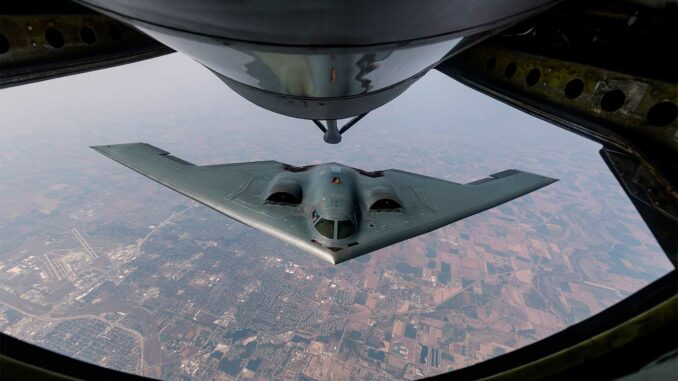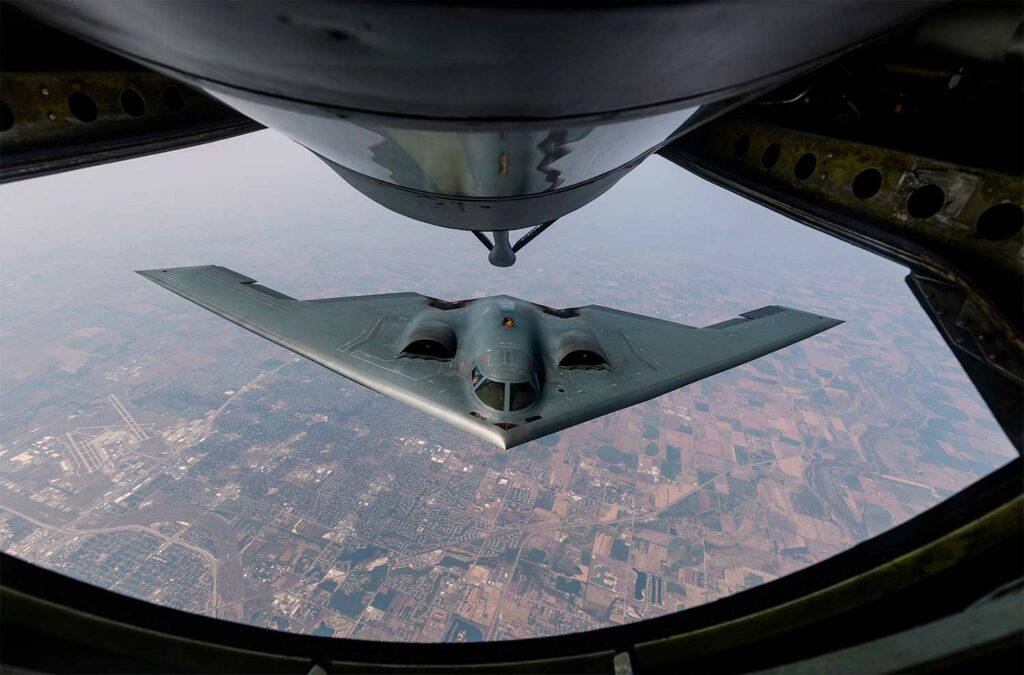
Technical and military study of the stealth design of the B-2 Spirit, an American strategic bomber designed to avoid radar detection.
The B-2 Spirit is a strategic bomber designed by Northrop Grumman to penetrate advanced air defenses. Entering service in 1997, it remains one of the few operational stealth aircraft capable of long-range nuclear or conventional strike missions. Its design is based on a flying wing configuration, a structure with no tail or distinct fuselage, aimed at reducing radar cross section and thermal signature. Capable of flying over 10,400 km without refueling, the B-2 is optimized to cross areas protected by S-band and X-band radar systems. Its initial unit cost exceeds $1.9 billion, including development, manufacturing, and specific maintenance infrastructure. This program was conceived during the Cold War to penetrate Soviet territory, but remains suitable today for high-intensity warfare, including against modern air defenses such as the Russian S-400 or the Chinese HQ-9.

A flying wing configuration to reduce radar signature
The most visible feature of the B-2 Spirit is its flying wing design. This design choice, with no vertical stabilizers, fuselage or tail, significantly reduces the aircraft’s radar cross section (RCS). The RCS of a B-2 is believed to be less than 0.1 m², equivalent to a small bird on a conventional radar.
This type of shape promotes angular diffusion of radar waves rather than direct reflection back to the transmitter. In addition, the leading edge angles (at 33°) are designed to minimize rearward reflections. The virtual absence of protrusions (no tail fin, no visible external jet engines) also helps to limit the radar signature.
Unlike other bombers such as the B-1 Lancer or the Tu-160, the B-2 does not rely on speed or maneuverability, but on passive radar invisibility, particularly against monostatic radars.
However, this shape has consequences for flight control. Without vertical stabilizing surfaces, aerodynamic stability must be ensured via integrated flight computers. The B-2 uses a quadruple redundant electric flight control system, piloted by algorithms designed to continuously adjust pitch, roll, and yaw through discreet adjustments of flaps or air brakes.
Materials and surface treatment for radar absorption
Beyond its shape, the coating of the B-2 Spirit plays an essential role in its stealth capabilities. The airframe is covered with a radar-absorbing material (RAM). This material, made from polymer resins, carbon fibers, and ferrites, absorbs electromagnetic waves instead of reflecting them. The coating is applied in several layers depending on the area, with particular attention paid to sensitive areas such as leading edges and air intakes.
This material is expensive and delicate. The B-2 requires more than 100 hours of maintenance for every hour of flight, much of which is devoted to maintaining the RAM skin. For example, after each mission, areas exposed to UV rays, temperature variations or minor impacts are tested using ultrasound and repaired with RAM patches.
The air intakes are also specially designed. They feature internal grid arrays called S-shaped ducts that block the direct line of sight to the turbines. The turbines themselves are covered with absorbent materials, and their exhaust temperature is reduced via a secondary cooling system, thereby reducing the infrared signature.
This approach allows the B-2 to remain stealthy in several spectra: radar, infrared, and acoustic. However, stealth remains more effective against shortwave radars (X-band, Ku-band) than against low-frequency radars (UHF, VHF), which are capable of partially detecting stealth aircraft at long ranges.
Performance, range, and mission profile
The B-2 Spirit is powered by four General Electric F118-GE-100 engines without afterburners, each delivering approximately 84 kN of thrust. These engines are integrated into the wing, which reduces both noise and radar and thermal drag.
The aircraft can fly at Mach 0.95, or approximately 1,015 km/h, at an altitude of 15,000 m. It has a range of 10,400 km without refueling and 18,500 km with in-flight refueling, enabling it to reach any target worldwide from the continental United States.
The B-2 is designed to operate deep into defended airspace. Its mission profile includes high-altitude flight to optimize fuel consumption, low-altitude descent on target approach to evade ground-based radar, and stealthy withdrawal.
It is capable of carrying up to 18 tons of munitions in two internal bays. It can deploy JDAM guided bombs, GBU-31 laser-guided bombs, or B61 or B83 nuclear bombs. All weapons are stored internally to preserve stealth.

Costs, maintenance, and operational limitations
The unit acquisition cost of the B-2 was one of the highest in military history. Originally, 132 aircraft were planned, but only 21 were produced due to the end of the Cold War and budget constraints. Each aircraft costs approximately $1.9 billion, including development, manufacturing, and specific infrastructure (air-conditioned hangars, RAM maintenance equipment).
Maintenance costs are also high. According to available data, one hour of flight time costs between €110,000 and €140,000. The maintenance of the RAM coating and the complexity of the onboard systems mean that the average availability rate is less than 60%, which remains problematic for a strategic vector that is supposed to be on permanent alert.
The B-2 also remains vulnerable to certain types of detection: metric wavelength radars, used by Russia and China, can detect a diffuse presence under certain conditions. In addition, the evolution of space observation capabilities, coupled with passive radar networks, requires continuous adaptation.
Outlook and developments in relation to the B-21 Raider program
The B-21 Raider program, also developed by Northrop Grumman, is intended to partially replace the B-2 Spirit by 2030. It is based on the same stealth principles, but incorporates digital architecture, reduced maintenance costs, and enhanced electronic warfare capabilities.
The B-21 is expected to cost around $650 million per unit, with simplified maintenance and an even lower radar signature. It is designed to operate in an intense electronic warfare environment, with direct integration into multi-domain combat networks.
However, the B-2 Spirit will remain active for at least another decade as a strategic nuclear deterrent platform. Its unique characteristics make it still relevant in first-strike or non-attributable strike scenarios in the event of a major crisis.
War Wings Daily is an independant magazine.